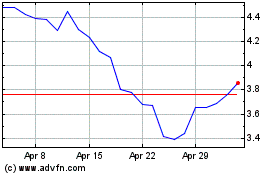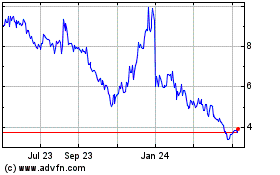Anavex Life Sciences Corp. (“Anavex” or the “Company”) (Nasdaq:
AVXL), a clinical-stage biopharmaceutical company developing
differentiated therapeutics for the treatment of neurodegenerative,
neurodevelopmental, and psychiatric disorders, including
Alzheimer's disease, Parkinson's disease, Rett syndrome,
schizophrenia, and other central nervous system (CNS) diseases,
today announced that the first patient in its U.S. FDA cleared
placebo-controlled Phase 2 clinical study of ANAVEX®3-71 for the
treatment of schizophrenia has been screened ahead of schedule.
“Initiating our Phase 2 trial of ANAVEX®3-71 in
schizophrenia ahead of schedule is a testament to the hard work and
dedication of our clinical study team,” stated Christopher U
Missling, PhD, President and Chief Executive Officer of Anavex.
“Schizophrenia is a challenging disorder that can impair social and
occupational functions and overall quality of life for the nearly
24 million people affected worldwide. Following on from our
positive initial Phase 1 results in healthy volunteers, our Phase 2
study will apply novel neuroinflammatory, metabolomic, and
transcriptomic biomarkers at the intersection of schizophrenia
pathophysiology and ANAVEX®3-71’s novel, dual mechanism of action,
with the goal of addressing the large unmet need in this patient
population. We are excited to build on our diverse Precision
Medicine Platform, which advanced blarcamesine (ANAVEX®2-73) onto a
regulatory pathway for potential treatment of Alzheimer’s
disease.”
ANAVEX®3-71’s differentiated mechanism is a dual
SIGMAR1 receptor agonist and M1 positive allosteric modulator with
agonistic effects.1,2 This novel mechanism of action offers the
potential to treat all symptom domains of schizophrenia -- positive
symptoms (hallucinations and delusions), negative symptoms
(difficulty enjoying life and withdrawal from others), and
cognitive impairment (deficits in memory, concentration, and
decision-making) -- without the side effects of standard of care
antipsychotics, which do not adequately address all symptom domains
in schizophrenia. ANAVEX®3-71’s ability to modulate both SIGMAR1
and M1 receptors is expected to potentially address disruptions to
neuronal homeostasis observed in individuals with schizophrenia,
upstream of the targets leveraged by standard of care
medications.
Preceding this study, ANAVEX®3-71 demonstrated
an adequate safety profile in a Phase 1 trial in healthy
volunteers.3,4
ANAVEX®3-71 Phase 2 Program
Outline
The placebo-controlled Phase 2, two-part,
in-patient trial, ANAVEX®3-71-SZ-001 (NCT06245213), will
investigate the effects of ANAVEX®3-71 in patients with
schizophrenia.
- Part A is a double-blind, placebo-controlled, multiple
ascending dose trial. The results of Part A will be used to select
a dose for Part B, a proof-of-concept efficacy, double-blind,
placebo-controlled trial.
- Participants will undergo either 10 or 28 days of dosing (Part
A and Part B, respectively).
- Standard clinical outcome measures, including the Positive and
Negative Syndrome Scale (PANSS), and novel fluid and
electrophysiological biomarkers will be assessed.
Anavex is leveraging several advances in
electroencephalography/event-related potential (EEG/ERP) biomarkers
in schizophrenia developed in collaboration with the industry-led
ERP Biomarker Qualification Consortium.5 This includes a validated,
and automated data analysis pipeline for quantitative EEG and ERP
biomarkers, as well as normative EEG/ERP data in patients with
schizophrenia and matched healthy volunteers. These advances also
include recently established relationships between EEG/ERP
biomarkers and clinically important measures in schizophrenia.
In addition to the electrophysiological
biomarkers, Anavex is applying novel neuroinflammatory,
metabolomic, and transcriptomic biomarkers at the intersection of
schizophrenia pathophysiology and ANAVEX®3-71’s novel, dual
mechanism of action.
About Schizophrenia
Schizophrenia is a persistent and often
disabling mental illness impacting how a person thinks, feels, and
behaves, and affects nearly 24 million people worldwide, including
2.8 million people in the U.S. It is characterized by three symptom
domains: positive symptoms (hallucinations and delusions), negative
symptoms (difficulty enjoying life and withdrawal from others), and
cognitive impairment (deficits in memory, concentration, and
decision-making). In part due to limitations with current
treatments, people living with schizophrenia often struggle to
maintain employment, live independently, and manage relationships.
While current treatments can be effective in managing select
symptoms, approximately 34% of people do not respond to therapy, 6
with an additional 50-60% experiencing only a partial improvement
in symptoms or unacceptable side effects.7
About Anavex Life Sciences Corp.
Anavex Life Sciences Corp. (Nasdaq: AVXL) is a
publicly traded biopharmaceutical company dedicated to the
development of novel therapeutics for the treatment of
neurodegenerative and neurodevelopmental disorders, including
Alzheimer's disease, Parkinson's disease, Rett syndrome,
schizophrenia and other central nervous system (CNS) diseases,
pain, and various types of cancer. Anavex's lead drug candidate,
ANAVEX®2-73 (blarcamesine), has successfully completed a Phase 2a
and a Phase 2b/3 clinical trial for Alzheimer's disease, a Phase 2
proof-of-concept study in Parkinson's disease dementia, and both a
Phase 2 and a Phase 3 study in adult patients and one Phase 2/3 in
pediatric patients with Rett syndrome. ANAVEX®2-73 is an orally
available drug candidate that restores cellular homeostasis by
targeting SIGMAR1 and muscarinic receptors. Preclinical studies
demonstrated its potential to halt and/or reverse the course of
Alzheimer's disease. ANAVEX®2-73 also exhibited anticonvulsant,
anti-amnesic, neuroprotective, and anti-depressant properties in
animal models, indicating its potential to treat additional CNS
disorders, including epilepsy. The Michael J. Fox Foundation for
Parkinson's Research previously awarded Anavex a research grant,
which fully funded a preclinical study to develop ANAVEX®2-73 for
the treatment of Parkinson's disease. ANAVEX®3-71, which targets
SIGMAR1 and M1 muscarinic receptors, is a promising clinical stage
drug candidate demonstrating disease-modifying activity against the
major hallmarks of Alzheimer's disease in transgenic (3xTg-AD)
mice, including cognitive deficits, amyloid, and tau pathologies.
In preclinical trials, ANAVEX®3-71 has shown beneficial effects on
mitochondrial dysfunction and neuroinflammation. Further
information is available at www.anavex.com. You can also connect
with the Company on Twitter, Facebook, Instagram, and LinkedIn.
Forward-Looking Statements
Statements in this press release that are not
strictly historical in nature are forward-looking statements. These
statements are only predictions based on current information and
expectations and involve a number of risks and uncertainties.
Actual events or results may differ materially from those projected
in any of such statements due to various factors, including the
risks set forth in the Company’s most recent Annual Report on Form
10-K filed with the SEC. Readers are cautioned not to place undue
reliance on these forward-looking statements, which speak only as
of the date hereof. All forward-looking statements are qualified in
their entirety by this cautionary statement and Anavex Life
Sciences Corp. undertakes no obligation to revise or update this
press release to reflect events or circumstances after the date
hereof.
For Further Information:Anavex
Life Sciences Corp.Research & Business DevelopmentToll-free:
1-844-689-3939Email: info@anavex.com
Investors:Andrew J.
BarwickiInvestor RelationsTel: 516-662-9461Email:
andrew@barwicki.com
1 Fisher A, Bezprozvanny I, Wu L, et al. AF710B, a Novel M1/σ1
Agonist with Therapeutic Efficacy in Animal Models of Alzheimer’s
Disease. Neurodegener Dis. 2016;16(1-2):95-110.
doi:10.1159/0004408642 Hall H, Iulita MF, Gubert P, et al. AF710B,
an M1/sigma-1 receptor agonist with long-lasting disease-modifying
properties in a transgenic rat model of Alzheimer's disease.
Alzheimers Dement. 2018;14(6):811-823.
doi:10.1016/j.jalz.2017.11.0093 Fadiran EO, Hammond E, Tran J, et
al. Concentration-QTc Relationship from a Single Ascending Dose
Study of ANAVEX3-71, a Novel Sigma-1 Receptor and Allosteric M1
Muscarinic Receptor Agonist in Development for the Treatment of
Frontotemporal Dementia, Schizophrenia, and Alzheimer's Disease.
Clin Pharmacol Drug Dev. 2023;12(9):888-901. doi:10.1002/cpdd.13034
Fadiran EO, Hammond E, Tran J, Missling CU, Ette E.
Population-Based Characterization of the Pharmacokinetics and Food
Effect of ANAVEX3-71, a Novel Sigma-1 Receptor and Allosteric M1
Muscarinic Receptor Agonist in Development for Treatment of
Frontotemporal Dementia, Schizophrenia, and Alzheimer Disease. Clin
Pharmacol Drug Dev. 2024;13(1):21-31. doi:10.1002/cpdd.13235 Cecchi
M, Adachi M, Basile A, et al. Validation of a suite of ERP and QEEG
biomarkers in a pre-competitive, industry-led study in subjects
with schizophrenia and healthy volunteers. Schizophr Res.
2023;254:178-189. doi:10.1016/j.schres.2023.02.0186 Potkin SG, Kane
JM, Correll CU, et al. The neurobiology of treatment-resistant
schizophrenia: paths to antipsychotic resistance and a roadmap for
future research. NPJ Schizophr. 2020;6(1):1. Published 2020 Jan 7.
doi:10.1038/s41537-019-0090-z7 Nucifora FC Jr, Woznica E, Lee BJ,
Cascella N, Sawa A. Treatment resistant schizophrenia: Clinical,
biological, and therapeutic perspectives. Neurobiol Dis.
2019;131:104257. doi:10.1016/j.nbd.2018.08.016
Anavex Life Sciences (NASDAQ:AVXL)
Historical Stock Chart
From Jan 2025 to Feb 2025

Anavex Life Sciences (NASDAQ:AVXL)
Historical Stock Chart
From Feb 2024 to Feb 2025
